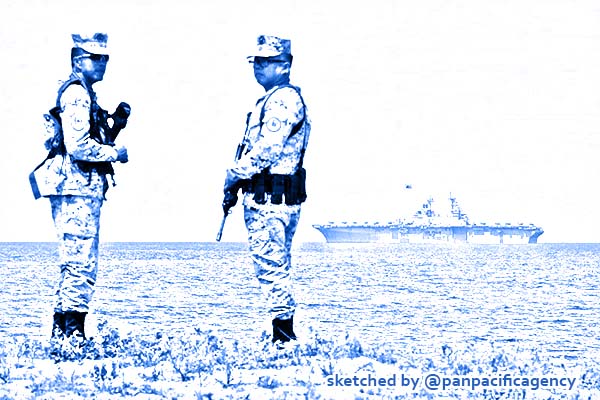‘Middle power’ Philippines ranks 17th in Asia power index

In this Apr. 11, 2019 photo, two Filipino soldiers are seen with the USS Wasp at the background while waiting for the amphibious landing exercise for the annual Balikatan exercise in Zambales. The US remains the most powerful country in the Asia Pacific while the Philippines ranked 17th out of 25 countries, according to the 2019 Asia Power Index released by Australia-based Lowy Institute. The STAR/KJ Rosales. Sketched by the Pan Pacific Agency.
MANILA, May 29, 2019, PhilStar. The Philippines dropped one place lower from its overall ranking in the 2019 Asia Power Index released by Australia-based think tank Lowy Institute, reported the Philippine Star.
For 2019, the Philippines ranked 17th out of 25 countries with an overall score of 13.7 out of 100, which is one spot lower from last year’s 16th place.
“The Philippines’ overall power ranking dropped by one place from last year, falling behind North Korea to the 17th place,” the report read.
The think tank, however, labelled Manila as a “middle power” in Asia despite its relatively low scores.
The index measured eight types of power — military capability, defense networks, economic resources, economic relationships, diplomatic influence, cultural influence, resilience and future resources.
The Philippines scored the highest in the defense networks category ranking 11th with 23.5 points while it ranked the lowest in resilience, placing 20th with 22.7 points.
The think tank attributed the country’s low resilience score to poor institutional stability.
Manila’s greatest improvement was in the economic relationships measure, where it ranked 14th, one place higher from last year.
The index also showed that Philippine military capability remains among the lowest in the region with a score of 6.4, ranking 19th out of 25.
China closing in on US
The United States remains the most powerful country out of the 25 countries measured by Lowy Institute but China is rapidly closing in on Washington.
The US obtained an overall score of 84.5 while China scored 75.9 in the second place. The think tank noted that the biggest challenge for Beijing’s rise to power is not Washington but itself as it faces political and structural challenges.
“The United States claims the top spot in four of the eight Index measures and its overall power score – the only country to top 80 points – remains unchanged from last year. Yet under most scenarios, short of war, the United States is unlikely to halt the narrowing power differential between itself and China,” the report read.
Aside from China, North Korea also saw the the highest overall gains in power for this year.
Pyongyang jumped six places from last year’s 21st place a year after the first meeting between North Korean leader Kom Jong Un and US President Donald Trump.
“North Korea’s high-stakes power game pays off for it in 2019, but is far from complete,” Lowy said.
Completing the top 10 powerful countries in Asia Pacific are Japan (42.5), India (41), Russia (35.4), South Korea (32.7), Australia (31.3), Singapore (27.9), Malaysia (22.8) and Thailand (20.7).
Lowy came up with the power index of the 25 countries in Asia Pacific using publicly available sources and its own resources.
“The Lowy Institute quantifies power in two main ways. Resource measures assess what capabilities countries have, and influence measures look at what countries do with the capabilities they have. In this sense, the Index seeks to capture both the material and situational factors involved in the exercise of power,” it said.